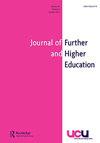Student-centred learning and teaching: a systematic mapping review of empirical research
IF 2.4
Q1 EDUCATION & EDUCATIONAL RESEARCH
引用次数: 0
Abstract
ABSTRACTStudent-centred learning and teaching (SCLT) has become a widespread approach in higher education and is praised by students, educational researchers and policy makers alike. SCLT is believed to help students become self-directed learners by placing them at the centre of the learning process. Despite the central role currently ascribed to SCLT in higher education, systematic knowledge about how it is practiced in higher education is limited. Informed by the findings of a systematic mapping review of empirical research, this article discloses how SCLT is practised inclass, outof-class and institutionally in higher educational institutions. Overall, we find that empirical research on SCLT is diverse and covers a wide range of pedagogical approaches and methods. Even so, the main focus of the research mapped is on in-class learning activities, whereas less focus is placed on student support systems and on how to develop a SCLT culture in institutional practices. Furthermore, the review finds an extensive focus on student activation and engagement in the empirical research on SCLT. This runs contrary to the theoretical literature arguing that SCLT should promote student agency and autonomy. We therefore encourage more empirical research on the relationship between SCLT and student agency in higher education.KEYWORDS: Student-centred learning and teachinghigher educationpedagogical approaches and methodssystematic mapping review Disclosure statementNo potential conflict of interest was reported by the author(s).Supplementary materialSupplemental data for this article can be accessed online at https://doi.org/10.1080/0309877X.2023.2241391Correction StatementThis article has been corrected with minor changes. These changes do not impact the academic content of the article.Notes1. Four items could not be retrieved in full text and were therefore discarded. Another four items were identified as duplicates and were also discarded.以学生为中心的学习与教学:实证研究的系统映射回顾
摘要以学生为中心的学习与教学(SCLT)已成为高等教育中广泛采用的一种教学方法,受到学生、教育研究者和政策制定者的一致好评。SCLT被认为是通过将学生置于学习过程的中心来帮助他们成为自主学习者。尽管目前在高等教育中被认为是SCLT的核心角色,但关于它如何在高等教育中实践的系统知识是有限的。本文通过对实证研究的系统分析,揭示了在高等教育机构中,学生在课堂上、课堂外和制度上是如何进行自我学习的。总体而言,我们发现对SCLT的实证研究是多样化的,涵盖了广泛的教学方法和方法。即便如此,研究地图的主要焦点还是在课堂学习活动上,而对学生支持系统和如何在机构实践中发展SCLT文化的关注较少。此外,本研究还发现,学生的激活度和参与度在SCLT的实证研究中得到了广泛关注。这与理论文献中认为SCLT应该促进学生的能动性和自主性的观点背道而驰。因此,我们鼓励更多的实证研究在高等教育的SCLT和学生代理的关系。关键词:以学生为中心的学习与教学高等教育教学方法与方法系统测绘综述披露声明作者未报告潜在的利益冲突。补充材料这篇文章的补充数据可以在网上访问https://doi.org/10.1080/0309877X.2023.2241391Correction声明这篇文章已经进行了细微的修改。这些变化不影响文章的学术内容。有四个项目无法全文检索,因此被丢弃。另外四个项目被确定为重复,也被丢弃。
本文章由计算机程序翻译,如有差异,请以英文原文为准。
求助全文
约1分钟内获得全文
求助全文
来源期刊

JOURNAL OF FURTHER AND HIGHER EDUCATION
EDUCATION & EDUCATIONAL RESEARCH-
CiteScore
5.20
自引率
4.30%
发文量
80
期刊介绍:
Journal of Further and Higher Education is an international, peer-reviewed journal publishing scholarly work that represents the whole field of post-16 education and training. The journal engages with a diverse range of topics within the field including management and administration, teacher education and training, curriculum, staff and institutional development, and teaching and learning strategies and processes. Through encouraging engagement with and around policy, contemporary pedagogic issues and professional concerns within different educational systems around the globe, Journal of Further and Higher Education is committed to promoting excellence by providing a forum for scholarly debate and evaluation. Articles that are accepted for publication probe and offer original insights in an accessible, succinct style, and debate and critique practice, research, theory. They offer informed perspectives on contextual and professional matters and critically examine the relationship between theory and practice across the spectrum of further and higher education.
 求助内容:
求助内容: 应助结果提醒方式:
应助结果提醒方式:


